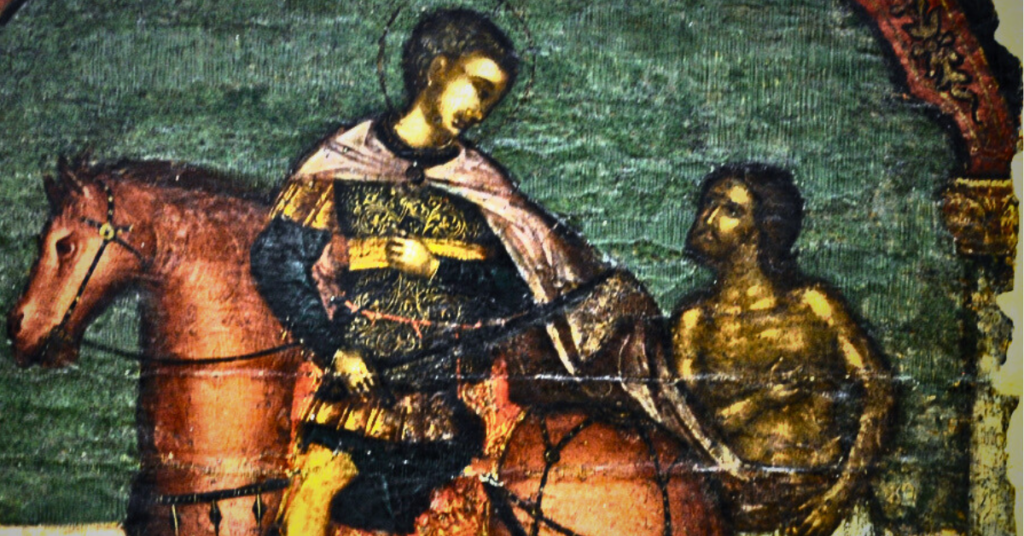Memories pile upon memories, and traditions accumulate warmth and spirit over time.
I participated in a St. Martin’s Day (or Martinmas) lantern walk during my first disorienting year at boarding school. My missionary parents were in intensive language study in a Kosovar village at the time, and I was living with twelve other children in the former schoolhouse of a quiet German town. My 1st grade class worked hard to make colorful construction paper lanterns that week, and then we joined crowds of other children at dusk and walked through forest paths and cobblestone streets as the stars lit up, singing the songs we’d diligently been practicing for days, before meeting back at the central town church for a service I don’t remember at all. The nonsensical songs have stuck with me ever since, though. For example:
Ich geh mit meiner Laterne,
Und meine Laterne mit mir.
Dort oben leuchten die Sterne
Und unten leuchten wir.
Mein Licht ist aus,
Ich geh nach Haus,
Rabimmel, rabammel, rabum!
I walk with my lantern,
And my lantern with me.
The stars are shining above,
And we shine here below.
My light is out,
I go home,
Rabimmel, rabammel, rabum!
The origins of the tradition
But what on earth does St. Martin of Tours have to do with German school children caroling with handmade lanterns on November 11th each year? Maybe not much. When I took to the internet to answer that question, I couldn’t find anything definitive in St. Martin’s story that made the tradition “make sense.”
Here’s what I did find out about him:
- His most beloved and defining story: upon seeing a beggar shivering in the snow, St. Martin drew his sword and cut his ultra-fancy scarlet military cloak in half to share. His fellow legionnaires poked fun at his shredded finery, of course, but he stood firm on Jesus’ words: “Whatever you did for the least of these, you did for me.”
- St. Martin was uncomfortable with his position in the Roman legions, given his deeper allegiance to Christ; he was thrown in prison for refusing to fight, and offered to take to the battlefield unarmed (but peace was declared before he had to make his stand).
- Some stories say that when his loyal friends wanted to make him Bishop, his modesty led him to hide in a pen of geese to avoid the honor. Unfortunately their noise gave him away. That’s why another Martinmas tradition involves eating roast goose—tit for tat, I suppose.
The iterations of the tradition
But lanterns in the deepening cold of mid-autumn? No one quite agrees on where that originated. When Rudolf Steiner’s Waldorf school model came to the United States, it brought the tradition along, and eventually some other alternative school systems picked it up—which is how I unexpectedly found myself participating in another Martinmas lantern walk 20 years later, while teaching at a forest school in Boise, Idaho.
We started under the boughs of a towering box elder tree, lit beeswax candles, and sang as we walked—English songs this time, like “Twinkle, Twinkle, Little Star.” The teacher tasked with shepherding our students through the event focused her introduction on a celebration of light and the rhythms of nature, rather than on any tales of St. Martin or Christlike compassion.

I also have a church friend who takes a group of kids from her homeschool co-op on the Martinmas lantern walk each year, and though they do center on the story of St. Martin, they take it a step further by organizing a coat drive, as well—moving the spirit of Martin’s story into action. That was never a part of the original tradition, but it is a deeply good thing. What’s more, it “makes sense.”
Traditions that “make sense”—and traditions that don’t
Growing up, my family had homemade enchiladas every Christmas Eve. One person shredded the chicken, one grated the cheese, others dipped tortillas in the homemade sauce. That tradition came out of nowhere and for no reason. We did it once, we liked it, and so we did it every Christmas Eve ad infinitum. On the other hand, our tradition of having all four children sleep in the living room in the light of the tree that night? My mom did the same with her siblings growing up, and Christmas was the time half of us finally came home from boarding school and we’d missed each other and it was just a rare and special thing. That one made sense.
I’m not arguing that the “why” of our traditions is completely irrelevant, only that some make obvious sense, thanks to theological symbolism or historical precedent, and others may make less sense. Think about your own traditions—the ones practiced in your church, your home, when you get together with old friends. How many of them arose seemingly out of thin air, yet continue on as something solid and deeply meaningful regardless, because of those memories piled upon memories, because of the spirit and warmth they accumulated over time? For children across the world, that’s the Martinmas lantern walk. The simple act of singing and glimmering together as a community holds meaning for them, whether or not they know exactly why.
For many of us everyday Christians in the pews, accepting the cup, doing our best to keep in tune through the hymns and steeling our introverted selves for the passing of the peace, the “why” of every theological point or sacrament or rhythm doesn’t always need to be one that unfolds all the way in the mind. When I sing, in my Orthodox church, “Let us, who mystically represent the cherubim and sing the thrice-holy hymn to the life-creating Trinity, lay aside all earthly cares,” I may at first have about as much of an understanding of what I’m saying as six-year-old me did while singing “Rabimmel, rabammel, rabum!” on St. Martin’s Day all those years ago. But as I keep singing, participating, and living into these things that are initially mysterious or even nonsensical, my inquisitiveness, sense of the deeper meaning, and an understanding of one kind or another does take shape.
What is faith, anyway, but some kind of wild balance between understanding and not understanding—a relationship between a community and an incarnate but unknowable God? Let’s all take a deep breath, my fellow rationalism-raised Westerners, and let ourselves say: if some facet of the church service, the theology, or the liturgy doesn’t make total sense to individualistic little me, maybe that’s okay, and still good, and still meaningful, and still deeply honoring to God.




Just lovely!